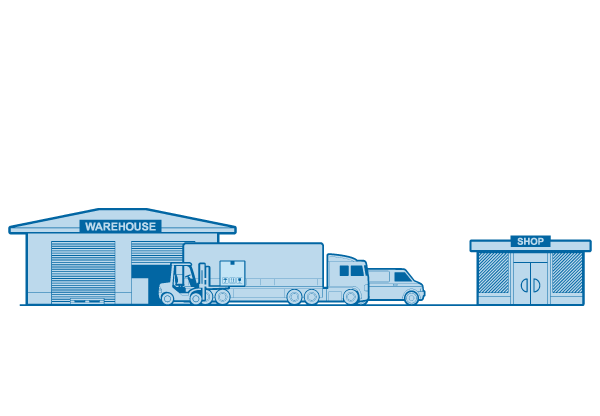No matter what mode of freight shipping and what type of truck you’re using, some things remain consistent, such as the available location types.
The main location types are businesses, residences, limited access locations, and tradeshows.
Business
For a location to be considered a business, it has to be located in a commercial area. Businesses in residential areas or home businesses are considered residential locations.
The reason for the stricter criteria for categorizing businesses is that despite your actual location being a business, if a driver has to maneuver through a residential area, that does impact their maneuverability and speed of movement. Sometimes, smaller trucks have to be sent out specifically if a location is unable to accommodate a 53’ truck.
Businesses are further divided into two categories: businesses with docks and those without docks.
This part is relatively self-explanatory. A business can either have or not have a loading dock or an alternative for one such as a forklift.
Businesses without docks/forklifts will generally require tailgates to unload the cargo from a truck.
Residences are not specific to the shipping industry, although there are specific requirements when shipping to or from residences.
Residential
Just like businesses with no docks, residences are likely to require tailgates as well. In addition to that, some residential areas might require straight trucks for the driver to be able to reach them.
Residential deliveries will require appointments as well. The carrier will call the consignee to make sure that somebody is at home at the time of the delivery.
When it comes to picking up from residences, however, things are a bit different. Carriers do not schedule appointments for pickups, regardless of the location type.
In some cases, carriers may refuse to pick up from residential locations altogether. In such situations, shippers can consider dropping their cargo off at a carrier’s terminal or checking beforehand if a carrier is willing to pick up their shipment.
Limited Access
Limited access locations are all non-standard businesses.
Farms, hospitals, churches, military bases, universities, etc., all fall under limited access. These are just some examples, but any location with a gate, that doesn’t have a dock, requires an appointment, or is generally not open to the public within standard business hours can be considered limited access. Something as simple as increased pedestrian traffic in an area can lead to a location being labeled as limited access as well.
Amazon deliveries, for instance, are shipments going to Amazon facilities and require appointments for delivery.
Not all carriers will perform deliveries to Amazon. Our system, however, cleverly filters carriers that do and don’t deliver to their locations for your convenience.
Amazon sites are large commercial buildings with docks, so why would they be classified as limited access? Amazon requires reference and shipment ID numbers to accept cargo coming in. Waiting times for drivers can sometimes last for hours and a specific appointment through Amazon’s portal is always required. This is enough for them to not be considered a standard business.
Trade Show
Trade Shows are their own specific category and just like with Amazon, not all carriers will perform these services.
“Tradeshow shipments” require additional paperwork (Material Handling Agreement (MHA)) which needs to be filled out correctly to avoid additional charges.
On this document, Freightera needs to be listed as the bill-to party (if shipping with us) to avoid any rebilling charges. The document needs to list the carrier performing the actual transportation of the goods on the appropriate line.
In addition to the above, tradeshow shipments also need to have the booth number listed on the BOL and they require an appointment to be set up.
In many instances, our clients would like the carrier to perform what is known as a “return shipment” which means that the carrier will bring the shipment to the appropriate destination and then pick it up again from the tradeshow and deliver it to another location (most often this would be the original pickup location).

